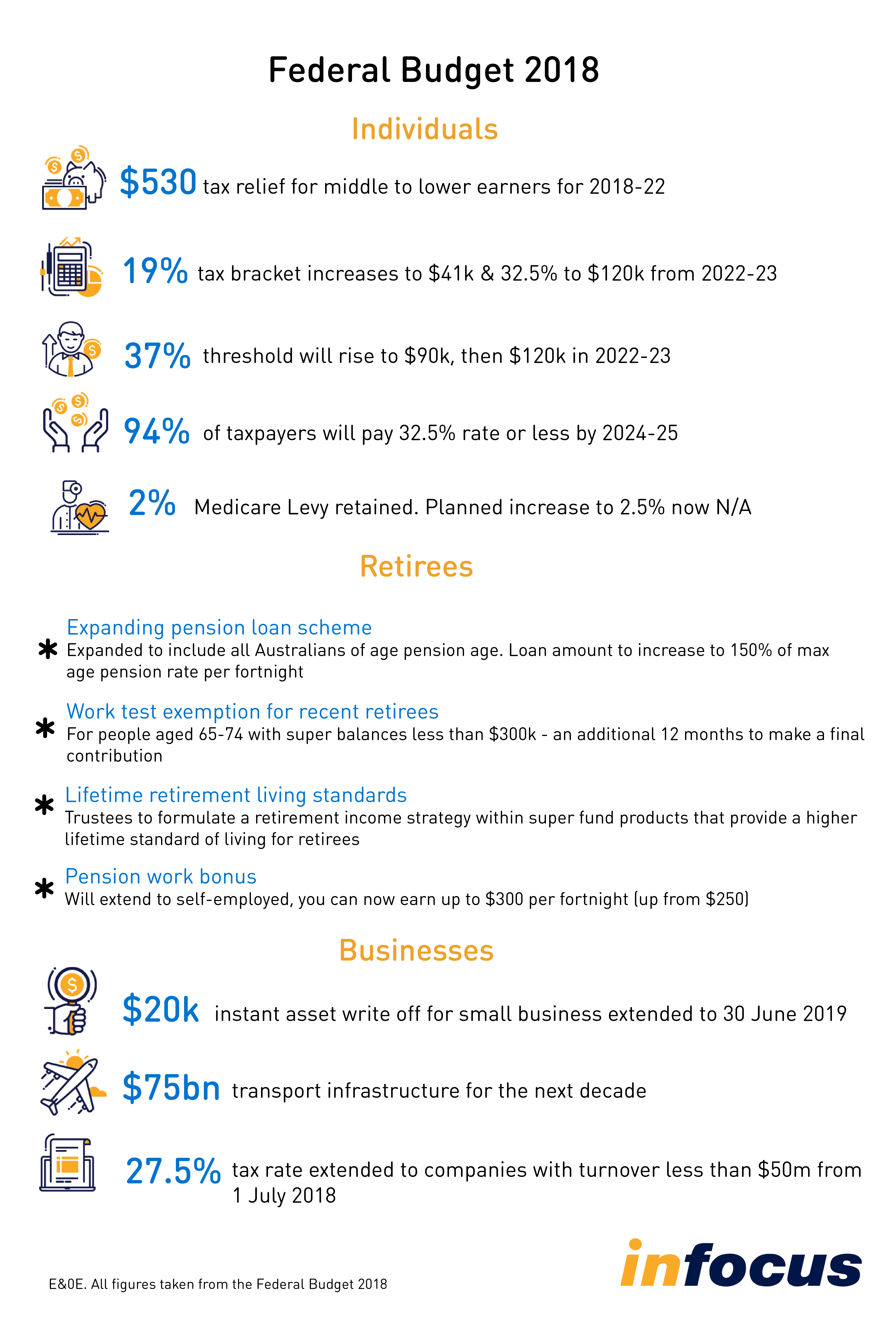Within this month’s update, we share with you a snapshot of economic occurrences both nationally and from around the globe.
Underlying economic growth is great!
– New pockets of growth keep emerging
– Markets have responded positively
– The Federal Reserve rate rise shows confidence
We hope you find this month’s Economic Update as informative as always. If you have any feedback or would like to discuss any aspect of this report, please contact your Financial Adviser.
The Big Picture
As we drifted into the end of the financial year, the economic fundamentals continued to strengthen. People spoke of coordinated global growth. And any expectations of recessions here, or in major foreign countries, are far off.The Big Picture
But there were a number of ‘noisy’ events to disturb this rosy picture of growth. There was the Singapore summit between Trump and North Korea leader, Kim Jong-Un. Talk of tariffs and trade wars kept hitting the news wires. And, at home, we had income tax cuts passing into legislation but corporate tax cuts stalling.
The ASX 200 followed an unusually independent path in June. Normally, the Wall Street overnight leads are strong indicators for what happens here – but not so in June.
We posted an impressive gain of +3.0% for our index over June while Wall Street struggled to make a gain of only +0.5%. We had a number of sectors performing particularly well – but it was Financials that drove the market. As by far the largest sector, Financials posted an impressive gain of +4.1% in June. The Banking Royal Commission steams ahead but investors seem to be over it.
Over the financial year, the ASX 200 posted a well-above average capital gain of +8.3% which converts into a total return of +13.0% when dividends are reinvested (but not franking credits). Five of the 11 sectors posted total returns of over 25% in the last 12 months.
The US Federal Reserve (the “Fed”) put its benchmark interest rate up by 0.25% points. This was widely expected but the tone of the press conference led analysts to believe that there may now be two more hikes in 2018 rather than the one most had previously expected.
It is good that the Fed is confident enough in the strength of its economy to edge rates up to their “neutral” level. It will take three more hikes before anyone can conclude that the Fed is ready to start tightening to slow down growth. By mid-2019, the US should be back to normal after a decade of negotiating one crisis after another.
There was also good news in a number of countries from which we do not normally expect to be pleasantly surprised. Spain posted economic growth at an impressive 3%. Greece posted its fifth successive quarter of growth and renegotiated its debt deal. Japan surprised markets with a monthly Industrial Production read of +0.4% when ?0.8% had been expected. And, finally, Australia posted +3.1% economic growth for the year when +2.8% was expected!
Some of the enthusiasm on our market should be attributed to the government getting the income tax cuts through parliament. However, corporate tax cuts are another matter.
Cutting corporate tax rates makes Australian companies more competitive in a global economy. Our current rate is particularly high. Lower taxes should make for better growth and employment. It is fifties-esque politicking to say that tax cuts are just for the big end of town. Just look how the US economy responded to its corporate tax cuts.
Our unemployment rate did fall to 5.4% from 5.6% the previous month but these numbers do wobble about and 5.4% is not an historically low number.
The big problem we see for Australia is that the household savings ratio is falling steeply towards zero from around 10%. We are starting to repeat the debt binge of 2000-2007. The fall in the ratio helps growth. When its stalls there is no longer a contribution to growth and employment will suffer.
We are looking forward to another good year but it won’t last much longer unless the government or the RBA acts soon.
Asset Classes
Australian Equities
Our ASX 200 had a solid month posting a total return (i.e. including dividends) of +3.3%. Energy was the best performing sector with +7.8% but Consumer Staples, IT and Utilities all had total returns above +6%. Telcos had another bad month losing ?5.8%. Financials (including the big banks) had a strong month with a total return of +4.1%
The Energy sector also led total returns for the financial year with a gain of 41.6% on a gain in Brent Oil prices of +62.5%. At the other end of the spectrum, Telcos lost ?30.9%. The Utilities sector, at ?0.8%, was the only other to go backwards over the financial year.
We are predicting a below average – but positive – capital gain for the broader index for FY’19. But, with dividends and franking credits, our predicted ‘grossed up’ return is around +9%.
We have the index slightly overpriced to start the new financial year but volatility is well-contained.
Foreign Equities
The world index was down ?0.6% on the month which makes our return look even more impressive.
China’s Shanghai Composite index is now down by more than 20% since its peak earlier in the year.
Over our financial year, our index (+8.3%) just underperformed the world index (+8.5%). The US’s S&P 500 had a capital gain of +12.2% and the Japan Nikkei at 11.3% was not far behind.
Bonds and Interest Rates
The Fed hiked rates in June but it has made it quite clear that it will tolerate slightly above target input data before it considers tightening. This is the sweet spot for growth.
The RBA had rates on hold as all expected. The European Central Bank (ECB) came out more dovish than was expected. The Bank of Japan also was on hold. No one is rushing to stifle growth – partly because wage growth around the world is low.
Other Assets
There have been a number of supply issues with oil production leading to some North American shale oil producers coming back on line.
Over the financial year, oil prices were up about 62.5% while prices for gold and iron ore were flat. Copper prices were up just over 10%.
Regional Analysis
Australia
The monthly read on the labour force was quite good – but not enough to get excited about. At least the slide in the strength of the market over the last few months seems to have been arrested. Economic growth at 3.1% for the year was a pleasant surprise but the chances of staying around that number are not great.
Income tax cuts were introduced but it will take seven years for the full package to work its way through the economy. The corporate tax cuts’ bill has stalled. Unfortunately, the debate has slipped into an “us and them” war. The real issue is global. If our companies have to pay higher taxes than their overseas competitors, they will take their businesses and jobs overseas – or suffer lower growth at home.
China
China is standing up well to the US over trade and tariffs. It is quite possible that something good will come out of the negotiations even if the style of these interchanges is not what we are used to.
US
The US unemployment rate just came in at 3.8% and there has not been a lower figure since 1974! Trump and his tax cuts seem to be working.
223,000 new jobs were created when only 188,000 were expected – and the previous month’s number was revised upwards by 10,000!
More importantly wages growth came in at 2.7% against an expectation of 2.1%. This is the first real sign that wages are starting to react to jobs data. There really is light at the end of the tunnel.
Europe
Greece has at last got a new debt deal after seven years of austerity. Its PM wore a tie for the first time over this period to celebrate (as he promised he would if a deal got done)! Greece posted five consecutive quarters of positive economic growth and the unemployment rate has fallen from dizzy heights to below 20%.
Spain posted strong growth at 3%. The UK even made some progress in its Brexit debate.
The ECB has been considering tapering for its bond purchase programme. But it came out of its meeting a little more dovish than expected. The ECB is moving gradually and that has helped growth.
The EU is thrashing out new policies on immigration. Compromises are being reached for a more equitable distribution of immigrants.
Rest of the World
It is not clear what will come from the US – North Korea summit on the latter’s nuclear programme. That the summit was even held is extremely positive and both sides seem to have given some wiggle room to the other.
And in a quirk of the soccer World Cup, England supporters cheered on only its second loss ever to Belgium as coming second in its table means it doesn’t play Brazil until the final – should they both make it. For a similar reason in another match, Japan gave up trying in the second half despite being 1-0 down.


